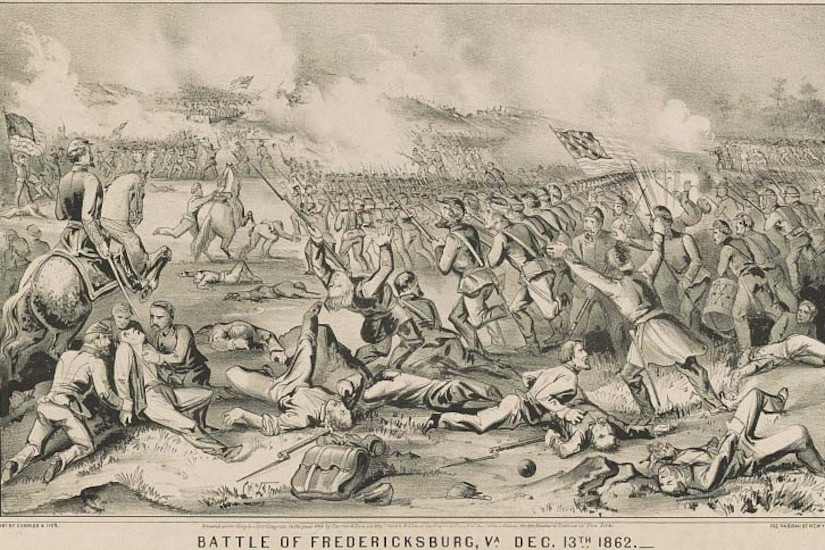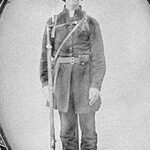The American Civil War, a defining period in U.S. history, saw extraordinary acts of valor, with 1,522 Medals of Honor awarded to Union soldiers – nearly half of all recipients since the medal’s inception in 1861. Among these heroes was Private George Maynard of the Union Army. His story, emblematic of the dedication and bravery symbolized by the Uniform Union Soldier wore, is one of selfless courage on the battlefield. Maynard’s unwavering commitment to his fellow soldier during the bloody Battle of Fredericksburg stands as a testament to the values embodied by the Union Army.
Born in 1836 in a Boston suburb, George Maynard received a public school education until the age of 15. He then began an apprenticeship as a jeweler, a trade he pursued until he was 25. In 1861, with the outbreak of the Civil War, Maynard enlisted in the 13th Regiment Massachusetts Volunteer Infantry. Like countless others answering the call to preserve the Union, Maynard donned the iconic uniform of a Union soldier, a symbol of the ideals and the sacrifices of the era. This uniform, typically consisting of a dark blue wool coat and light blue trousers, represented not just military affiliation but also a commitment to a nation divided.
 Union soldier in dark blue uniform coat and light blue trousers standing outdoors, holding a rifle.
Union soldier in dark blue uniform coat and light blue trousers standing outdoors, holding a rifle.
The 13th Massachusetts was deployed to patrol the Upper Potomac River along the Maryland-Virginia border. These early days of service quickly transitioned into the harsh realities of war as Maynard and his regiment participated in several significant and brutal engagements. They faced Confederate forces at the Second Battle of Bull Run, Chantilly, and Antietam – the single bloodiest day in American history. These battles were a severe test for the Union soldiers, many of whom were new to combat, yet they stood firm, their uniforms bearing witness to the smoke and grime of war.
December 12, 1862, marked a pivotal moment in Maynard’s military service. His regiment crossed the Rappahannock River, positioning themselves for the Battle of Fredericksburg. History remembers Fredericksburg as a devastatingly one-sided Confederate victory. The fighting at Slaughter Pen Farm was particularly intense. Union forces initially broke through Confederate lines but were ultimately driven back by a fierce counterattack. Maynard’s regiment was at the forefront of the Union advance, pushing into the face of enemy fire. During the chaotic retreat and regrouping, Maynard realized that a fellow soldier, Charles Armstrong, was missing.
Disregarding the immense danger, Private Maynard turned back towards the thick of battle to find Armstrong. Under heavy enemy fire, Maynard located his comrade and, with extraordinary effort and bravery, managed to bring the wounded soldier back to the relative safety of a Union field hospital. Tragically, Armstrong succumbed to his injuries. Maynard’s selfless action, risking his own life to save another, exemplified the highest ideals of camaraderie and courage expected of a Union soldier. It was an act of valor that would later be recognized with the nation’s highest military honor.
By February 1863, the 13th Massachusetts was mustered out of service, and Maynard briefly left the Army. However, his commitment to service called him back. In 1864, he re-enlisted, receiving a commission as a captain in the 82nd U.S. Colored Infantry. This regiment participated in the siege and battle of Fort Blakely, Alabama, further demonstrating Maynard’s dedication to the Union cause. His consistent service and leadership led to his promotion to Major in recognition of his contributions.
Maynard concluded his military service in September 1866 and returned to Boston. He built a life there, marrying and raising a family. Decades later, on March 20, 1898, the nation formally recognized his remarkable bravery at Fredericksburg with the Medal of Honor. This award underscored the significance of his selfless actions performed in the uniform of a Union soldier.
George Maynard lived a long life, passing away in 1927 at the age of 91. His legacy of courage and selflessness endures. Today, his Medal of Honor and his Union Army uniform are preserved and displayed at Boston’s historic Faneuil Hall. Alongside them is a painting depicting his heroic act at Fredericksburg, ensuring that future generations remember the valor of this Union soldier. In retirement, Maynard remained active in the Ancient and Honorable Artillery Company of Massachusetts, a testament to his lifelong dedication to service. Each year, members of this organization honor his memory with a wreath-laying ceremony at his grave, keeping alive the story of a man who exemplified the true spirit of a Union soldier.

 Drawing depicting a chaotic Civil War battle scene with soldiers in blue uniforms retreating under heavy fire.
Drawing depicting a chaotic Civil War battle scene with soldiers in blue uniforms retreating under heavy fire.  Museum interior featuring Civil War artifacts, paintings, and glass display cases exhibiting historical items.
Museum interior featuring Civil War artifacts, paintings, and glass display cases exhibiting historical items. 